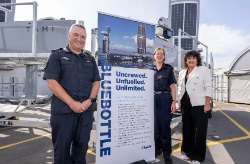New Zealand hoki fishery recertified
PRESS RELEASE
1 November 2007
New Zealand hoki fishery recertified to MSC environmental standard
Fishing industry leaders were pleased at the announcement today of the re-certification of the hoki fishery by the Marine Stewardship Council (MSC)1.
“The recertification of the hoki fishery under the MSC programme provides an independent assessment that this fishery remains amongst the best sustainably managed fisheries in the world,” said Deepwater Stakeholder Group (DWG)2 chief executive George Clement.
“We welcome this final decision after a two year process recognising that the standards against which we have been assessed are much higher than in the first certification in 2001. We embrace sustainable fisheries management as a process of continual improvement and the MSC programme provides the fishery with an independent audit that we are continuing with world’s best practice in this regard.”
This is not about perfection it is about optimum performance, Mr Clement said.
“We recognise the reduced western stock size, induced by environmental changes over the past decade, and concerns about the environmental effects of trawling provides us with challenges to continually adopt new management measures. We are up for these challenges and our programmes are well underway. Consumers can continue to choose New Zealand hoki with the confidence that remains sustainably managed.”
Managing Director of Sanford Limited Eric Barratt said that independent certification of fisheries will increasingly be demanded by New Zealand’s international seafood markets.
“The re-certification of hoki is very important to the fishing industry and we look forward to working on certification for other key fisheries.”
“We are constantly working to improve the management of our deepwater fisheries. We have already put many improvements in place in the hoki fishery and these have been recognised by the Marine Stewardship Council”.
The ongoing certification depends on the fishery fulfilling a time-bound action plan to ensure it continues to meet the conditions set out in the certification report, to be verified by annual audits. The main features of the action plan are:
· Developing and implementing a plan to rebuild the depleted western stock, to be updated annually with the first step having already been taken through a 38% catch reduction from 1 October this year
· Reducing the risks of injury or deaths of seabirds,particularly albatross, by managing offal discards from hoki trawlers and deploying bird mitigation measures. This programme has already been implemented and audited through the Ministry of Fisheries scientific observer programme.
· Closer management of fisheries interactions with fur seas, with seven specific actions to improve information and promote effective by-catch mitigation, all to be completed within 15 months of certification.
· The implementation of a Fisheries Plan during the next 12 months that will include an clear management objectives and information requirements for both hoki stocks and an updated Ecological Risk Assessment that reassesses management objectives in relation to fisheries interactions with the marine environment
· The development and implementation of Benthic Protection Areas, that extend across 30% of the New Zealand 200 mile EEZ and protect a broad range of representative benthic habitats and ecosystems from modification by trawl, including significant areas in the hoki fishery
· A strategic overview of the management system for hoki and associated by catch species which will be externally reviewed.
· A formal agreement between hoki quota owners and the Ministry of Fisheries committing to collaborative strategic and operational management and currently supported by over 95% of hoki quota owners through their shareholding in DWG.
George Clement noted: “The active collaboration between the Ministry of Fisheries and DWG has been very successful in improving the management of the hoki fishery. The integration of operational management has lead to a reduction in catch over-runs from 5% to less than 1%, a significant reduction in seabird injuries and deaths and improved information from the fishery. The next stage is the development of a fully integrated management plan for the fishery by mid 2008, which will encompass all of the MSC requirements.”
Owen Symmans, CEO of the Seafood
Industry Council, commented: “All New Zealanders can take
heart in this MSC re-certification – New Zealand fisheries
management, is internationally recognised as among the
best in the world .New Zealand industry continues to be at
the forefront of innovative solutions to ensure sustainable
and environmentally sound fisheries
practices.”
ENDS


 Gordon Campbell: On The Left’s Electability Crisis, And The Abundance Ecotopia
Gordon Campbell: On The Left’s Electability Crisis, And The Abundance Ecotopia NZCAST: NZCAST Leads Ongoing Cross-Agency Collaboration To Break Down Barriers For Survivors Of State Abuse
NZCAST: NZCAST Leads Ongoing Cross-Agency Collaboration To Break Down Barriers For Survivors Of State Abuse Regional and Unitary Councils Aotearoa: Regional And Unitary Councils Back A Practical FWFP System
Regional and Unitary Councils Aotearoa: Regional And Unitary Councils Back A Practical FWFP System NZ Government: Stay Safe On Our Roads This Easter
NZ Government: Stay Safe On Our Roads This Easter YWCA: Global Push Back Against Gender Equality A Growing Crisis In Aotearoa
YWCA: Global Push Back Against Gender Equality A Growing Crisis In Aotearoa Te Pāti Māori: Ngarewa-Packer - Fast-Tracking Seabed Mining Ignores Māori Opposition And Environmental Precedent
Te Pāti Māori: Ngarewa-Packer - Fast-Tracking Seabed Mining Ignores Māori Opposition And Environmental Precedent New Zealand Defence Force: Defence And Customs Strengthen Maritime Security With Uncrewed Surface Vessels
New Zealand Defence Force: Defence And Customs Strengthen Maritime Security With Uncrewed Surface Vessels


